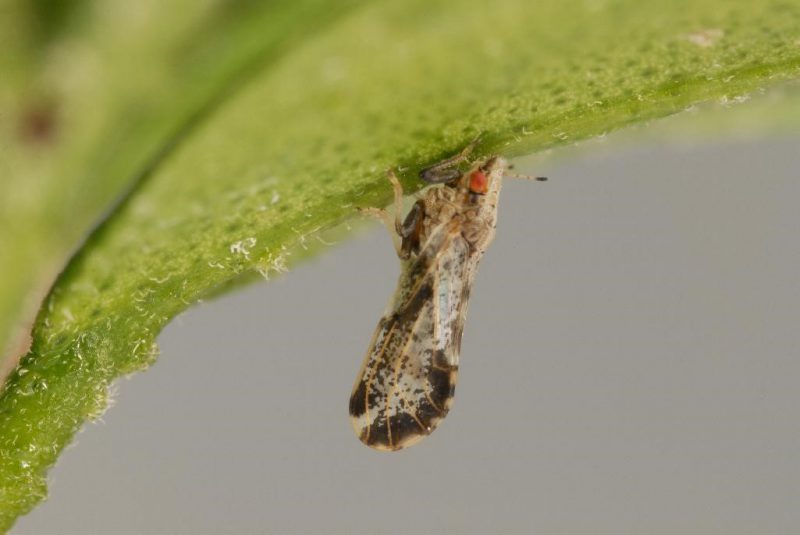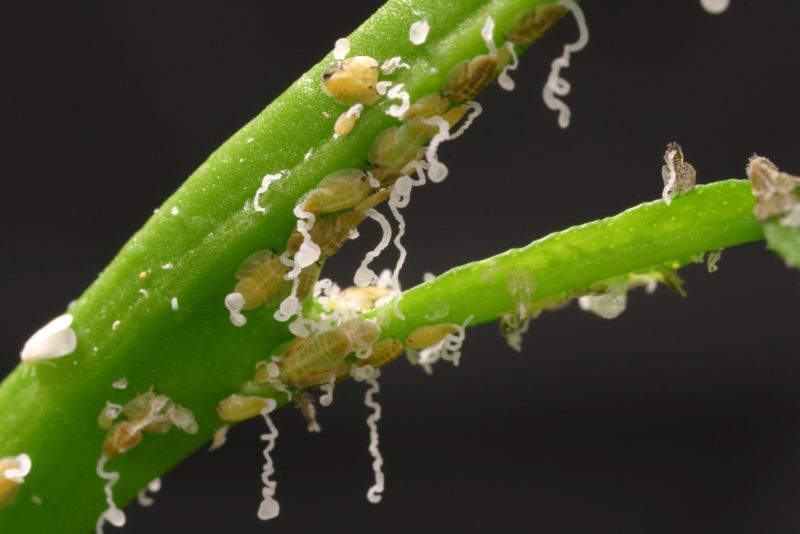There has been an increasing interest in growing cold hardy citrus in North Florida. While the production of citrus is still minimal, compared to the Florida Peninsula, the acreage of citrus is now above 400 acres in the Panhandle. Packing houses and a juice plant have been established in North Florida, so this region is poised for the expansion of a diverse, fresh market citrus industry. In addition to satsuma, new varieties such as Tango or Sugar bell are being integrated by North Florida growers. However, this recent success is under the threat of citrus greening , which is spread by the Asian citrus psyllid.
–
Citrus greening is the most devastating disease affecting citrus, and has already infected over 80% of citrus in the Florida Peninsula. Citrus production in Florida has decreased by more than 60% due to this disease. Citrus greening is caused by an infectious bacterium that is transmitted by the Asian citrus psyllid. Symptoms commonly associated with the disease include fruit drop, misshapen and sour fruit, defoliation, and eventually tree death.
In 2017, researchers at the North Florida Research and Education Center (NFREC) discovered citrus infected by citrus greening in the Florida Panhandle for the first time, and our lab was simultaneously finding important populations of Asian citrus psyllid along the Gulf of Mexico. All together, the associated presence of the pathogen and the vector was a very stressful situation for North Florida growers, and the future of the cold hardy citrus industry.
Two years later, the situation of citrus greening and Asian citrus psyllid is still under control. Asian citrus psyllid populations in the Panhandle are mostly cornered in counties along the coast of the Gulf of Mexico. Franklin, Gulf, and Bay Counties currently have the highest populations. The psyllid populations are almost exclusively found in urban areas in backyard trees, but very rarely found in commercial groves. So far, psyllids have been spotted only once in a commercial grove, and the population was eradicated immediately. Trees that were found to be infected in Taylor and Suwanee counties have been removed to decrease the inoculum. All other groves in Gadsden, Liberty, and Jefferson counties are still negative for both the psyllid and citrus greening. Simultaneously, UF/IFAS is pursuing an extension effort through organized workshops to educate growers and homeowners on citrus greening. Growers are encouraged to attend the upcoming training in Quincy – Citrus Health Forum – March 12.
–
Current recommendations for Asian citrus psyllid and citrus greening management in North Florida:
-
Monitor your grove for Asian citrus psyllid: The Asian citrus psyllid populations in North Florida are at the highest between June and November. It is during this period that the risk of infestation is particularly elevated. Asian citrus psyllid monitoring can be conducted with yellow sticky traps placed on the border of the citrus grove, at shoulder height and on a spot well exposed to sun (Asian citrus psyllids are highly attracted by light and avoid shade). Regular inspection of young, emerging leaves is also recommended as this is where the adults, eggs, and nymphs are mostly found (Fig. 1, 2 and 3).
- Remove infected trees: As the current citrus greening infection is low in the panhandle, it is recommended to remove any citrus greening trees. Aggressive removal of infected trees is one of the contributing factors credited for maintaining citrus greening below 20% among commercial citrus trees in Brazil.
- If you find Asian citrus psyllid in your citrus grove, do not wait: Any populations of Asian citrus psyllid should be controlled quickly. The insecticides to be used against Asian citrus psyllid are listed in the Florida Citrus Production Guide. New adult populations can be targeted with broad-spectrum insecticides (organophosphates or pyrethroids).
- If your nonbearing trees are already protected against leafminers with a program of soil-applied systemic insecticides (neonicotinoid and cyantraniliprole), these insecticides are also efficient against Asian citrus psyllids. You do not need to apply more soil-applied systemic insecticides against Asian citrus psyllid.
- If psyllids appear at the beginning of the fruiting stage, it might be a good idea to use insecticides that may also target rust mites such as Spirotetramat, Tolfenpyrad or Fenpyroximate.
- In any case, do not make any preventive insecticide sprays (only spray if you find Asian citrus psyllid in your grove), and avoid spraying during the blooming season, when bees are actively foraging.
- Sap Beetles are Not a Cause of Concern for Citrus but Katydids Are - October 4, 2024
- The Importance of Pollination for Seedless Watermelons and How to Enhance it - April 5, 2024
- New Perspectives for the Management of Invasive Air Potato Vine - November 17, 2023



